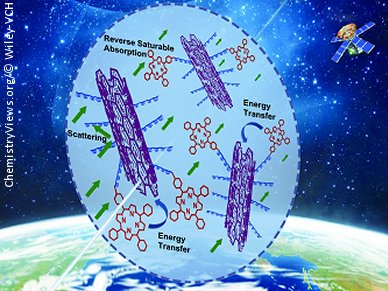Carbon nanotubes (CNTs) exhibit remarkable electrical and mechanical properties; however, their use in building various photovoltaic and composite materials remains a challenge owing to their insolubility in most organic and aqueous solvents.
A collaboration of four research groups under the auspices of the China–Australia Joint Research Center for Functional Molecular Materials and led by Chi Zhang, Jiangnan and Jiangsu Universities, China, have discovered that by using 1,3-dipolar cycloaddition reactions, multi-walled CNTs (MWCNTs) can be functionalized with porphyrin groups to give composite materials. The solubility and dispersion stability of these materials in organic solvents are significantly improved through this covalent linkage between the MWCNTs and the porphyrin groups.
Another consequence of this functionalization is that there is significant fluorescence quenching of the porphyrin dyes following bonding to the MWCNTs. This quenching is due to the electron/energy transfer from the excited porphyrins to the MWCNTs and leads to good nonlinear optical performance.
Hence, these new nanohybrids are promising candidates for photonic and optoelectronic devices.
- Facile Synthesis and Enhanced Nonlinear Optical Properties of Porphyrin-Functionalized Multi-Walled Carbon Nanotubes,
A. Wang, Y. Fang, L. Long, Y. Song, W. Yu, W. Zhao, M. P. Cifuentes, M. G. Humphrey, C. Zhang,
Chem. Eur. J. 2013.
DOI: 10.1002/chem.201302477



